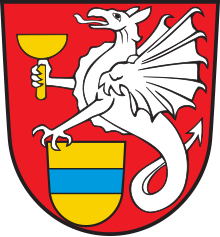Club
The Knüpfel , Klipfel, Klüpfel , Klöpfel or mallet is a hammer-like tool made of wood for wood and stone sculptors , stonemasons or natural stone mechanics , carpenters , carpenters , cooper and other woodworking professions, as well as farriers .
functionality
Blanks differ from hammers in the real sense in that their head has an all-round striking surface; you don't need to turn it in any direction to hit. This also means that the billet cannot exert any axial torque on the forearm and hand. The face of most clubs is not cylindrical-parallel to the handle, but slightly conical and roughly in line with the wrist.
The billet is very similar to the beater and has the same area of application. The only difference is that the head of the billet is round when viewed from above, while the head of the beater is roughly cuboid. As with the mallet, the clubface (track) is not parallel to the handle, but in an axis with the wrist.
Materials and dimensions
The classic billet has a turned wooden body made of hornbeam , 10–24 cm in diameter. The head can also be made of other types of wood, such as bubinga or laurel wood, as well as metals such as brass , bronze and iron , or suitable plastics. The handle is only so long that the fist on the head encloses it, with a handle diameter of almost 3 cm and mostly ergonomic thickenings in the middle and at the free end, and is made of oak , ash or acacia .
So that wooden logs do not burst, they must be protected from moisture, heat and solar radiation. The mallet is often made of several parts glued together to prevent the wood from tearing. Worn out pegs are turned, by removing material and consequently lower weight, they can be used as cornice pegs for finer work.
Typical variants of the classic billet:
- Ø 115 mm 0.95 kg = wooden sticks Ø 120 mm
- Ø 115 mm 1.05 kg = wooden club Ø 130 mm
- Ø 130 mm 1.20 kg = wooden sticks Ø 140 mm
- Ø 130 mm 1.35 kg = wooden club Ø 150 mm
- Ø 130 mm 1.50 kg = wooden club Ø 160 mm
- Ø 140 mm 1.50 kg = wooden club Ø 160 mm
- Ø 140 mm 1.70 kg = wooden club Ø 170 mm
- Ø 140 mm 1.90 kg = wooden sticks Ø 180 mm
Knüpfel types of the individual professions
A distinction is made between cylindrical , conical and bell-shaped head shapes, the most common shape being that of a rounded cone.
- The billet is used by stonemasons and stone sculptors in place of the hand mallet to drive the chisels with billet heads when working on soft stone . The wooden tool prevents the stone surface from being bruised. With this use of the billet, the stone or sculptures are formed from natural stone or the billet is used to design the surface of the soft stone (as with scratching ). The billet head for stone processing is also available made of plastic. Plastic clubs have proven their worth due to the lower wear and tear, in the colors - brown - for hard cut and - blue - for soft cut. Furthermore, metal billets are used by southern stonemasons (France, Portugal) and are now also used in Germany. As the stone tool is driven, billets are constantly being turned from cut to cut in the hand. This avoids one-sided stress on the wrist and one-sided wear on the log.
- Knüpfel be of carpenters instead of knocking wood used. When driving chisels (chisels) , wood sculptors use knots as "accompanying tools" when forming sculptures by driving the carving chisels (chisels) with them. Carpenters use larger carpenter's clubs for this . The round shape protects against hand injuries when slipping.
- Farriers use the billet along with the rivet blade to open the nail rivet in a horseshoe. The round shape protects the sensitive horn-forming fringe and the bones above the hoof from injuries if the blow misses the rivet blade due to unpredictable movement of the horse.


